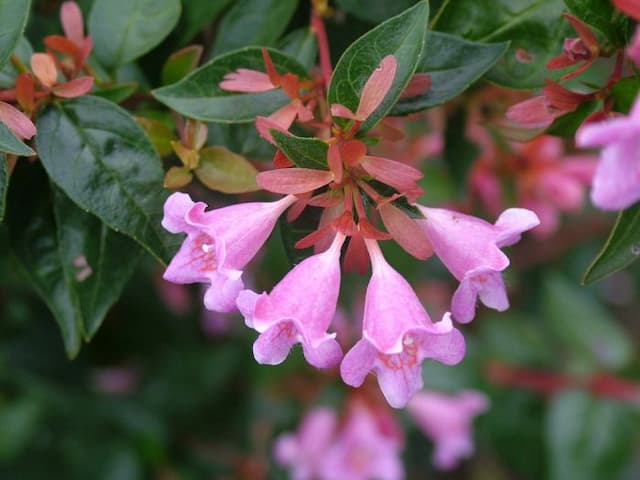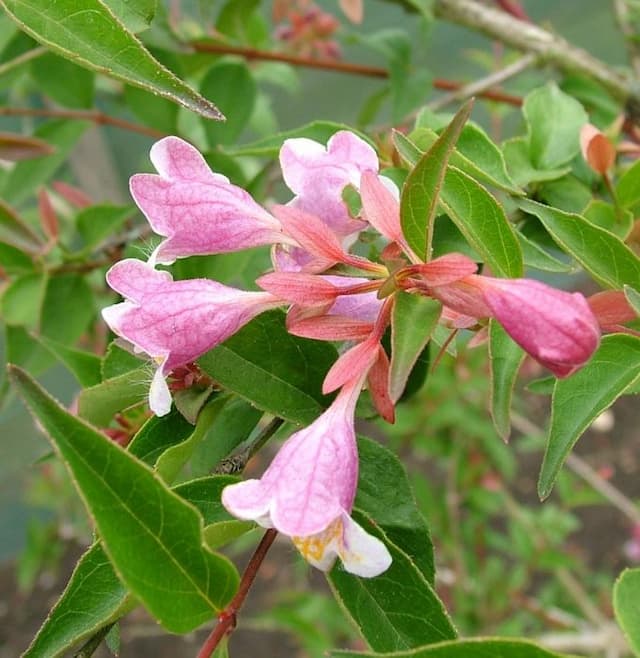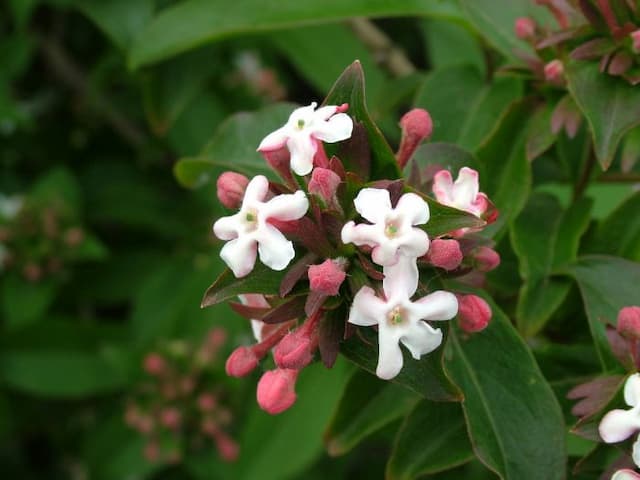Elisae Honeysuckle Lonicera elisae

ABOUT
The Lonicera elisae, also known as honeysuckle, is a plant with a visually distinct and appealing appearance. It is characterized by its long, tubular flowers that often come in a striking combination of colors such as yellow, white, or pink. These blossoms are known not just for their ornate shape but also for their delightful fragrance, which is most potent during the evening hours, attracting pollinators such as moths and bees. The leaves of the honeysuckle are usually oval-shaped, and they exhibit a lush green hue that serves as the perfect backdrop to highlight the vibrant colors of its flowers. These leaves might appear in pairs opposite each other along the stem, and some may be united at the base. Depending on the variety, some honeysuckles are evergreen, while others may lose their leaves in colder climates, revealing a tangle of woody stems that add an interesting structure to the garden landscape even in winter. The twining nature of honeysuckle vines allows it to climb trellises, walls, or other supports, lending it a draped or cascading aesthetic that is quite distinctive. The fruits of the honeysuckle, typically berries, can vary in color from red to blue or black, depending on the specific type of honeysuckle. These berries often attract wildlife, such as birds, which find them to be a valuable food source. However, it should be noted that in some species, the berries might be toxic to humans if ingested. The overall appearance of the honeysuckle plant is one of rustic charm and delicate beauty, with its intertwined stems, vibrant blooms, and enduring leaves. It is a favorite among gardeners and nature enthusiasts alike for its visual appeal and the sweet scent that enhances outdoor spaces.
About this plant
 Names
NamesFamily
Caprifoliaceae
Synonyms
Elisae Honeysuckle
Common names
Lonicera elisae
 Toxicity
ToxicityTo humans
Lonicera elisae, commonly known as honeysuckle, can vary in toxicity depending on the specific species, as some honeysuckle species are considered toxic while others are not. However, it is often advised to regard honeysuckles with caution and avoid ingesting parts of the plant unless you are certain of their safety. Generally, when honeysuckle is toxic, ingestion can cause symptoms such as stomach upset, vomiting, diarrhea, and in severe cases, it can lead to more serious effects like rapid heart rate or difficulty breathing. To ensure safety, it is best to keep honeysuckles out of reach of children and to not consume any part of the plant unless it is a known edible variety and part, such as the nectar of certain honeysuckle flowers which is sometimes consumed.
To pets
For pets, Lonicera elisae or honeysuckle may be toxic depending on the species. As with humans, some species are non-toxic while others can be harmful if ingested. Common symptoms of honeysuckle poisoning in pets may include gastrointestinal upset such as vomiting or diarrhea. In more serious cases, toxicity can lead to lethargy, difficulty breathing, or increased heart rate. If a pet ingests honeysuckle, it is important to monitor the animal closely and consult with a veterinarian for advice and potential treatment. It is advisable to prevent pets from having access to honeysuckle plants or berries, as they may not discriminate between non-toxic and toxic varieties.
 Characteristics
CharacteristicsLife cycle
Perennials
Foliage type
Deciduous
Color of leaves
Green
Flower color
Yellow
Height
10 feet [3 meters]
Spread
6 feet [1.8 meters]
Plant type
Shrub
Hardiness zones
4
Native area
China
Benefits
 General Benefits
General Benefits- Aesthetic Appeal: Lonicera elisae, commonly known as honeysuckle, is often valued for its attractive flowers and foliage.
- Fragrance: The plant is known for its sweet and pleasant fragrance.
- Wildlife Attraction: Honeysuckle flowers attract hummingbirds, bees, and butterflies, which can aid in pollination.
- Potential for Hedging: This species can be used to create dense hedges or living fences.
- Erosion Control: Honeysuckle can help stabilize soil and prevent erosion on slopes or banks.
- Shade Tolerance: Lonicera elisae is capable of growing in partially shaded areas, offering landscaping options under trees or in less sunny spots.
- Seasonal Interest: The plant provides seasonal interest with its delicate blossoms in spring and sometimes berries in the autumn.
- Foliage: The green leaves of honeysuckle can add a lush element to gardens and outdoor spaces.
 Medical Properties
Medical Properties- This plant is not used for medical purposes.
 Air-purifying Qualities
Air-purifying QualitiesThis plant is not specifically known for air purifying qualities.
 Other Uses
Other Uses- Lonicera elisae, also known as honeysuckle, can be used as a natural garden fence due to its climbing nature, creating beautiful living barriers that provide privacy and support for bird life.
- The branches of honeysuckle can be woven into small crafts like baskets, providing a unique material for artisanal creations and contributing to sustainable crafting practices.
- The sweet scent of honeysuckle flowers makes it an excellent choice for a natural air freshener when placed in a vase, without the need for synthetic fragrances.
- Dried honeysuckle vines can serve as natural kindling material for campfires or fireplaces, offering an eco-friendly alternative to processed fire starters.
- The honeysuckle's robust growth can be utilized for erosion control on slopes or banks, as its roots help hold the soil in place, reducing soil erosion efficiently.
- During blooming season, honeysuckle can be used in educational settings to teach students about pollination, as it attracts a variety of pollinators including birds, bees, and butterflies.
- Honeysuckle flowers can be added to potpourri blends, which can impart a sweet fragrance to rooms and linen closets when used in fabric sachets.
- The nectar from honeysuckle flowers, while typically enjoyed by hummingbirds, can also be used as a sugar substitute in small quantities in homemade lemonades or teas for a touch of natural sweetness.
- The plant's ability to climb structures makes honeysuckle suitable for creative landscape designs, allowing gardeners to adorn archways, trellises, or pergolas with its foliage and flowers.
- Honeysuckle can provide habitat enrichment for wildlife in gardens, offering nesting sites and food sources which help support local biodiversity.
Interesting Facts
 Feng Shui
Feng ShuiThe plant Lonicera elisae, commonly known as honeysuckle, can be used in Feng Shui to attract positive energy and promote good luck. Placing honeysuckle in the Southeast area of a garden or home can enhance wealth and abundance, according to Feng Shui principles. Its sweet fragrance and vibrant flowers are believed to uplift the chi or life force, supporting harmony and prosperity.
 Zodiac Sign Compitability
Zodiac Sign CompitabilityThe plant Lonicera elisae, or honeysuckle, is not used in astrology practice.
 Plant Symbolism
Plant Symbolism- Devotion and Affection: Lonicera, commonly known as Honeysuckle, is often associated with strong bonds and affection. Its tendency to entwine around structures symbolizes the connection and devotion between people.
- Sweetness of Life: Honeysuckle, with its sweetly scented flowers, is thought to represent the sweetness and pleasure found in life's experiences.
- Generosity: With its abundant flowers and growth, Honeysuckle can symbolize generosity both in nature and in human behavior.
- Protection: Honeysuckle has been used traditionally to ward off evil, symbolizing protection and creating a safe haven.
- Nostalgia: The fragrance of Honeysuckle is known to evoke memories, often standing as a symbol for the powerful recollection of past joys and youth.
 Water
WaterFor the Lonicera elisae, commonly known as Honeysuckle, water the plant when the top inch of soil feels dry to the touch, approximately once a week. During the growing season, they may require more frequent watering, especially in hotter and drier climates, potentially increasing to twice a week. Use a watering can or hose to gently soak the soil around the plant, providing roughly 1 gallon of water to saturate the root zone. Be cautious not to waterlog the soil, as Honeysuckle does not like to sit in standing water. During the dormant winter months, reduce watering to every few weeks or when the soil is dry several inches down.
 Light
LightHoneysuckle thrives best in full sun to partial shade. It should be planted in a location that receives at least 6 hours of direct sunlight per day. A spot that provides morning sunlight and some afternoon shade is ideal, as this helps to protect the plant from the intense heat of the afternoon sun.
 Temperature
TemperatureHoneysuckle plants are quite hardy and can tolerate a range of temperatures. They perform well in temperatures between 60°F and 80°F, which are considered ideal growing conditions. However, they can usually survive in temperatures as low as 30°F and as high as 95°F without significant damage.
 Pruning
PruningHoneysuckle should be pruned to maintain shape, encourage bushiness, and remove any dead or diseased branches. Pruning is best done in late winter or early spring before new growth begins. Additionally, periodic thinning throughout the year helps to improve air circulation within the plant.
 Cleaning
CleaningAs needed
 Soil
SoilThe Lonicera elisae, commonly known as Honeysuckle, prefers well-draining soil that is rich in organic matter. A good soil mix would be composed of two parts loam, one part peat moss or well-rotted compost, and one part sand or perlite to ensure proper drainage. The pH of the soil should be slightly acidic to neutral, ideally between 5.5 and 7.0, to support healthy growth.
 Repotting
RepottingHoneysuckles such as Lonicera elisae should generally be repotted every two to three years to replenish nutrients and prevent root-bound conditions. When repotting, choose a container that is slightly larger than the previous one to allow for new growth. It's best to repot in the spring before the onset of the growing season.
 Humidity & Misting
Humidity & MistingHoneysuckle plants, like Lonicera elisae, flourish in moderate to high humidity levels. They are adaptable but maintaining a humidity range of 40-60% is beneficial for optimal growth. If grown indoors, regular misting or the use of a humidifier can help maintain these conditions.
 Suitable locations
Suitable locationsIndoor
Grow in bright, indirect sunlight with occasional misting.
Outdoor
Plant in well-drained soil; full sun to partial shade.
Hardiness zone
4-9 USDA
 Life cycle
Life cycleLonicera elisae, commonly known as honeysuckle, begins its life cycle as a seed which, under suitable conditions, germinates in the spring, sending out roots and shoots. The young plant then grows into a woody vine or shrub, depending on the variety, with stems that may twine or climb on nearby structures or other plants. It enters a vegetative stage where leaves develop, and it undergoes rapid growth. Following this, the honeysuckle enters the flowering stage, usually in late spring to early summer, where it produces fragrant flowers that can attract pollinators such as butterflies and bees. After pollination, flowers develop into small berries that contain seeds, completing its reproductive cycle. The plant then typically goes dormant in winter, conserving energy to repeat the cycle in the next growing season.
 Propogation
PropogationPropogation time
Spring to early summer
Propogation: The Lonicera elisae, commonly known as the honeysuckle, is often propagated through softwood cuttings during the late spring or early summer. This is when the plant is actively growing and the new stems are green and flexible. To carry this out, a cutting of about 4 to 6 inches (approximately 10 to 15 cm) is taken, ensuring there are at least two or three sets of leaves. The bottom set of leaves is removed, and the cut end may be dipped in rooting hormone to encourage root development. The cutting should then be placed in a pot with well-draining soil and kept moist until roots have developed enough for the plant to be transplanted into the garden. This method is favored for its straightforwardness and the high success rate in producing new, healthy plants.







![Himalayan honeysuckle [Golden Lanterns]](/_next/image?url=https%3A%2F%2Fplants-admin.emdemapps.com%2Fimages%2Fplants%2F%2Fimages%2F604b55302cc87.png&w=640&q=75)

